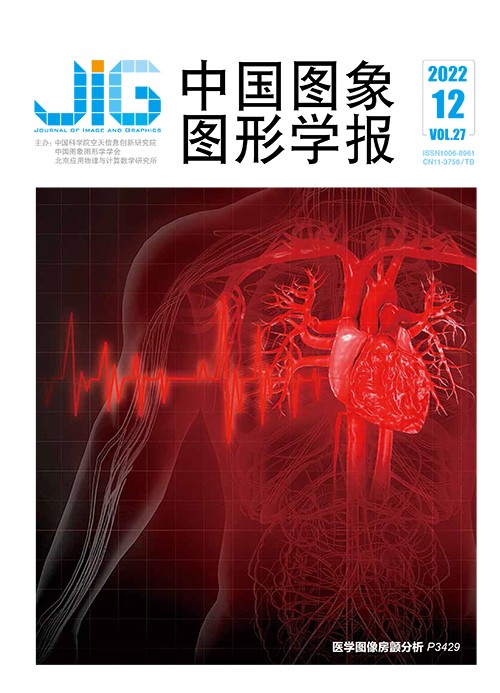
自适应非局部3维全变分彩色图像去噪
摘 要
目的 许多彩色图像去噪算法未充分利用图像局部和非局部的相似性信息,并且忽略了真实噪声在彩色图像不同区域内分布的差异,对不同图像块和不同颜色通道都进行同等处理,导致去噪图像中同时出现过平滑和欠平滑现象。针对这些问题,本文提出一种自适应非局部3维全变分去噪算法。方法 利用一个非局部3维全变分正则项获取彩色图像块内和块间的相似性信息,同时在优化模型的保真项内嵌入一个自适应权重矩阵,该权重矩阵可以根据每次迭代得到的中间去噪结果的剩余噪声来调整算法在每个图像块、每个颜色分量以及每次迭代中的去噪强度。结果 通过不同的高斯噪声添加方式得到两个彩色噪声图像数据集。将本文算法与其他6个基于全变分的算法进行比较,采用峰值信噪比(peak signal-to-noise ratio,PSNR)和结构相似性(structural similarity, SSIM)作为客观评价指标。相比于对比算法,本文算法在两个噪声图像数据集上的平均PSNR和SSIM分别提高了0.161.76 dB和0.12%6.13%,并获得了更好的图像视觉效果。结论 本文去噪算法不仅更好地兼顾了去噪与保边功能,而且提升了稳定性和鲁棒性,显示了在实际图像去噪中的应用潜力。
关键词
Color image denoising using adaptive non-local 3D total variation
Li Xiaoyao1,2, Wang Lianhong1, Zhou Yicong2, Zhang Jing1(1.College of Electrical and Information Engineering,Hunan University,Changsha 410082,China;2.Department of Computer and Information Science,University of Macau,Macau 999078,China) Abstract
Objective Images are often distorted by noise during image acquisition, transmission and storage process. The generated noise can degrade image quality and affect image processing, such as edge detection, image segmentation, image recognition and image classification. Image denoising technique plays a key role in image pre-processing for image details preservation. Current Gaussian noise removal denoising techniques is often based on variational model like the total variation (TV) method. It can realize image smoothing through minimizing the corresponding energy function. However, TV-based denoising methods have their staircase effects and detail loss due to local gradient information only. Many researchers integrate the non-local concept into the total variation model after the non-local means was proposed. The existing non-local TV-based methods take advantages of the non-local similarity to denoise the image while keeping the image structure information. Unfortunately, many existing TV-based color image denoising methods fail to fully capture both local and non-local correlations among different image patches, and ignore the fact that the realistic noise varies in different image patches and different color channels. These always lead to over-smoothing and under-smoothing in the denoising result. Our newly TV-based color image denoising method, named adaptive non-local 3D total variation (ANL3DTV), is developed to deal with that. Method 1) Decompose the noisy color image into K overlapping color image patches, search for the m most similar neighboring image patches to each center image patch and then group the m image patches together. 2) Vectorize every color image patch in each image patch group and stack them into a 2D noisy matrix. 3) Obtain the corresponding 2D denoised matrices via ANL3DTV. To get the inter-patch and intra-patch correlations, our ANL3DTV takes advantages of a non-local 3D total variation regularization. On the basis of embedding an adaptive weight matrix into the fidelity term of the optimization model, it can automatically control the denoising strength on different color image patches and different color channels in each iteration. The weight matrix is correlated with the estimated noise level of each image patch. 4) Aggregate all the denoised 2D matrices to reconstruct the denoised color image. Result According to different ways to add Gaussian noise, there are two cases in the denoising experiment. In Case 1, the noisy images are corrupted with Gaussian noise with the same noise variance in all color channels. The selected noise levels are σ= 10, 30 and 50. In Case 2, we add Gaussian noise with different noise variances to each color channel. The noise levels are [σR, σG, σB] = [5, 15, 10], [40, 50, 30], [5, 40, 15] and [40, 5, 25]. ANL3DTV is compared to 6 existing TV-based denoising methods. The peak signal-to-noise ratio (PSNR) and structure similarity (SSIM) are adopted to denoising evaluation. The averaged PSNR/SSIM results of ANL3DTV in Case 1 are 32.33 dB/92.99%, 26.92 dB/81.68 and 24.57 dB/73.57%, respectively, and the quantitative results of ANL3DTV in Case 2 are 31.62 dB/92.88%, 24.49 dB/73.02%, 27.47 dB/85.94% and 26.81 dB/81.00%, respectively. Compared with other competing methods, ANL3DTV improves PSNR and SSIM by about 0.161.76 dB and 0.12%6.13%. As can be seen from the denoised images, some competing methods oversmooth the images and lose many structure information. Some mistake noise pattern for the useful edge information and yield obvious ringring artifacts. Our ANL3DTV can remove more noise, preserve more details and suppress more artifacts than the competing methods. Conclusion We demonstrate an adaptive non-local 3D total variation model for Gaussian noise removal (ANL3DTV). To capture the inter-patch and intra-patch gradient information, ANL3DTV is focused on the non-local 3D total variation regularization. To adaptively adjust the denoising strength on each image patch and each color channel, an adaptive weight matrix into the fidelity term is introduced. To guarantee the feasibility of ANL3DTV mathematically, we develop the iterative solution of ANL3DTV and validate its convergence. The visual results demonstrate our ANL3DTV potentials in noise removal and detail preserving. Furthermore, ANL3DTV achieves more robustness and stablizes noise removal more under different noise levels.
Keywords
|



 中国图象图形学报 │ 京ICP备05080539号-4 │ 本系统由
中国图象图形学报 │ 京ICP备05080539号-4 │ 本系统由